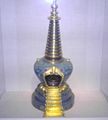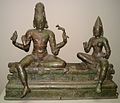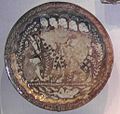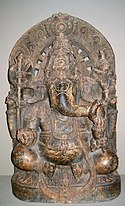Freer Gallery of Art
Die Freer Gallery of Art ist ein bedeutendes Kunstmuseum und Teil der Smithsonian Institution. Die Sammlung umfasst Kunst aus Ostasien (China, Korea, Japan), Südasien, Indien, Südostasien, Ägypten, Griechenland, dem antiken Vorderasien, sowie amerikanische Werke. Gemeinsam mit der Sackler Gallery bildet die Freer Gallery die Smithsonian Museums of Asian Art. Die Galerie öffnete 1923 für die Öffentlichkeit. Sie befindet sich an der Südseite der National Mall in Washington, D.C.
Geschichte
Die Galerie wurde von Charles Lang Freer (1854–1919), einem Hersteller von Eisenbahnwaggons aus Detroit, der den Vereinigten Staaten seine Sammlungen und die finanziellen Mittel für den Bau des Gebäudes schenkte, begründet. Die im italienischen Renaissance-Stil gestaltete Galerie wurde mit Granit und Marmor gebaut. Sie war von den italienischen Palazzi, die Freer bei seinen Reisen gesehen hatte, beeinflusst und vom amerikanischen Architekten Charles A. Platt entworfen. Als sie 1923 eröffnet wurde, war sie das erste Museum des Smithsonian, das sich den bildenden Künsten widmete. Das Freer war auch das erste Smithsonian Museum das aus dem Vermächtnis eines privaten Sammlers entstand. Bedingung für die Schenkung war, das Freer bis zu seinem Tod die volle Kontrolle über die Sammlung behielt. Das Smithsonian zögerte zuerst aufgrund der Auflage, aber die Fürsprache von Präsident Teddy Roosevelt wurde das Projekt durchgeführt. In den folgenden Jahren wuchs die Sammlungen, durch Schenkungen und Ankäufe, auf nahezu die dreifache Größe von Freers Vermächtnis.
Die Pflege der Sammlung begann schon, bevor das Museum existierte, als Charles Lang Freer den japanischen Gemälderestaurator zur Pflege seiner Werke und zur Vorbereitung auf ihre spätere Heimat als Teil der Smithsonian Institution einstellte. 1932 stellte die Freer Gallery of Art einen hauptberuflichen, japanischen Restaurator ein und schuf damit das spätere East Asian Painting Conservation Studio. Das Fachlabor und der erste Einsatz von wissenschaftlichen Methoden beim Studium der Kunst am Smithsonian begannen 1951, als der Chemiker Rutherford J. Gettens vom Fogg Art Museum an der Harvard University zur Freer Gallery wechselte. Das East Asian Painting Conservation Studio und das Labor wurden 1990 zur Abteilung Conservation & Scientific Research zusammengelegt.[1]
Die Freer Gallery ist auch eine bedeutende Forschungseinrichtung. Das Archiv der Freer Gallery umfasst unter anderem den umfangreichen Nachlass des in Persepolis, Pasargadae, Samarra, Paikuli und an vielen anderen Orten tätigen bedeutenden Archäologen und Ausgräbers Ernst Herzfeld (1879–1948), den persönlichen Nachlass von Charles Lang Freer, sowie umfangreiche Dokumente aus dem Nachlass des Archäologen Myron B. Smith (1897–1970) und einen Großteil des Nachlasses von Fotografien von Antoin Sevruguin (c.1830–1933).
Sammlungen
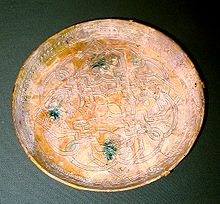
Zu den Favoriten der Besucher zählen Chinesisches Porzellan und Chinesische Malerei, koreanisches Porzellan und Steingut, antike ägyptische und vorderasiatische archäologische Objekte, japanische Wandschirmen, indischen und persischen Manuskripten und buddhistischen Skulpturen aus verschiedenen Regionen und Zeitaltern. Die Kunstwerke der Galerie reichen von der Jungsteinzeit bis zu Modernen Kunst, mit einer Vielzahl von bemalten Kunstwerken vor allem aus Song-Dynastie, Ming-Dynastie und Qing-Dynastie Chinas.
Ein Höhepunkt der Arbeiten von James McNeill Whistler[2] ist das Pfauen-Zimmer[3], ein für den britischen Reeder Frederick Richards Leyland entworfenes Speisezimmer. Im Jahr 1876 dekorierte Whistler den Raum reich mit einem blau-goldenen Pfauenmuster. Nach dem Tod des Besitzers kaufte Freer das komplette Zimmer auf, verschiffte es in die Vereinigten Staaten und stellte es in der Freer Gallery aus.
Galerie
- China
- Indien
- Ägypten
- Japan
- Nepal
- Persien
- Korea
- Syrien
- Kuschan
Einzelnachweise
- ↑ Conservation & Scientific Research ( des vom 28. September 2012 im Internet Archive) Info: Der Archivlink wurde automatisch eingesetzt und noch nicht geprüft. Bitte prüfe Original- und Archivlink gemäß Anleitung und entferne dann diesen Hinweis.
- ↑ Whistler ( des vom 4. Dezember 2004 im Internet Archive) Info: Der Archivlink wurde automatisch eingesetzt und noch nicht geprüft. Bitte prüfe Original- und Archivlink gemäß Anleitung und entferne dann diesen Hinweis.
- ↑ Peacock Room ( des vom 9. Dezember 2004 im Internet Archive) Info: Der Archivlink wurde automatisch eingesetzt und noch nicht geprüft. Bitte prüfe Original- und Archivlink gemäß Anleitung und entferne dann diesen Hinweis.
Weblinks
Koordinaten: 38° 53′ 17,1″ N, 77° 1′ 38,4″ W
Auf dieser Seite verwendete Medien
(c) PericlesofAthens in der Wikipedia auf Englisch, CC BY-SA 3.0
An Egyptian coffin mask made of wood and glass, from the New Kingdom, dated to Dynasty 18 or 19 (1550-1196 BC).
From the Freer and Sackler Galleries of Washington D.C.
- Author: en:User:PericlesofAthens
- Date: August 3, 2007
(c) PericlesofAthens in der Wikipedia auf Englisch, CC BY-SA 3.0
A en:Nepalese bodhisattva polychrome wooden statue from the Malla Kingdom, made in the 14th century. Although the current statue has six arms, two of the original arms were broken off and are now missing.
From the Freer and Sackler Galleries of Washington D.C.
- Author: en:User:PericlesofAthens
- Date: August 3, 2007
(c) PericlesofAthens in der Wikipedia auf Englisch, CC BY-SA 3.0
An early 14th century Kamakura period Japanese statue of the Amida Buddha, made of wood with gold leaf, crystal, linen, and lacquer.
From the Freer and Sackler Galleries of Washington D.C.
- Author: en:User:PericlesofAthens
- Date: August 3, 2007
Journey to Shu. Ink and color on silk. Blue-and-green style. H x W (painting): 54.9 x 183.2 cm (21 5/8 x 72 1/8 in). Traditionally attributed to Qiu Ying 仇英 (ca. 1494–1552), Calligraphy by Wen Zhengming 文徵明 (1470–1559). 16th-17th century, Ming dynasty.
Journey to Shu is one of several paintings that depict scenes from the famous love story of the emperor Ming Huang (Emperor Xuanzong) and his concubine Yang Guifei.
Painted in lavish mineral-based colors of blue, green, and brownish yellow, this painting is a typical “blue-and-green” landscape. This style originated during the Tang dynasty (618–907). It was often employed in later periods, such as the Ming dynasty (1368–1644) in this case, to evoke a past era of peace and prosperity. The current painting is modeled on a well-known landscape from the collection of National Palace Museum in Taipei. It was traditionally believed to represent the flight of Emperor Xuanzong (685–762) to Shu (Sichuan) in summer 756 CE during the An Lushan rebellion . However, its composition differs from its model in many ways, including the addition of an entire section of landscape and the conflict of season.
The painting depicts a dramatic landscape of towering blue and green mountains topped with coiling clouds. Four groups of travelers are marching through the landscape. From the right, several women riders, each wearing a piece of red clothing, emerge from the mountains accompanied by several men in front and at the rear. Proceeding left from the bridge, traveling merchants rest among trees. One of their horses rolls happily in the grass. The third group of travelers appear exhausted from the journey. Feeling concerned, the man riding in front looks back at his companions. At left, the fourth group is making their way up the mountain path, which leads to hanging roadways off dangerous cliffs. In the background, a large body of water recedes into the distance. Trees and flowers are blooming, suggesting it is springtime.
Emperor Minghuang's Journey to Sichuan; this section of a much larger en:Ming Dynasty (1368-1644) Chinese handscroll painting on silk shows Tang Minghuang, or en:Emperor Xuanzong of Tang, fleeing the capital en:Chang'an and the violence of the en:An Shi Rebellion that began in the year 755 during the mid en:Tang Dynasty. The scene shown in this painting follows the previous one, en:Yang Guifei Mounting a Horse. This handscroll painting is a late Ming copy after an original painting by the renowned Ming artist en:Qiu Ying (1494-1552).
From the Freer Gallery of Art and Arthur M. Sackler Gallery, the Smithsonian’s National Museum of Asian Art of Washington D.C.
- Author: en:User:PericlesofAthens
- Date: August 3, 2007
(c) PericlesofAthens in der Wikipedia auf Englisch, CC BY-SA 3.0
Egyptian miniature glassware vessels, from the New Kingdom, dated to the 18th Dynasty 1550-1307 BC. The method of production was to wind threads of molten glass around a core of sand, clay, and mud. These vessels were used mainly for storing perfumed ointments, scented oils, and cosmetics. They are thought to have been produced in royal workshops during the reign of either Amenhotep III or Akhenaten.
From the Freer and Sackler Galleries of Washington D.C.
- Author: en:User:PericlesofAthens
- Date: August 3, 2007
(c) PericlesofAthens in der Wikipedia auf Englisch, CC BY-SA 3.0
An early 13th century en:Persian ceramic bowl with a composite body painted over the glaze with enamel. The bowl perhaps served to commemorate a decisive battle as a military trophy, since the intricate artwork on the surface of the bowl displays horsemen charging against a hilltop fortress with defenders firing back arrows and launching debris from catapults. Specific clues may provide insight as to which battle this portrays, clues such as a load-bearing elephant being displayed.
From the Freer and Sackler Galleries of Washington D.C.
- Author: en:User:PericlesofAthens
- Date: August 3, 2007
(c) PericlesofAthens in der Wikipedia auf Englisch, CC BY-SA 3.0
A set of three en:Mamluk era en:Syrian-blown glassware vessels from the 14th century, complete with enamel and gilding decorations and calligraphic writing.
The central four-handled vase shown has a formidable international history: it was crafted sometime between 1325 to 1350 for the presiding sultan of the en:Rasulid Dynasty in en:Yemen, which ruled southern Arabia from 1229 to 1454. This particular vase created in Syria under the Mamluks was aimed to please the Rasulids, as it displays the characteristic five-petal rosettes associated with the Rasulids. The Rasulids Dynasty was a seapower in the Indian Ocean, largelly controlling sailed routes from East Asia to Africa. With contacts in East Asia, this vase eventually wound up in en:China, either arriving as a gift or brought back by a Chinese envoy visiting Yemen.
From the Freer and Sackler Galleries of Washington D.C.
- Author: en:User:PericlesofAthens
- Date: August 3, 2007
(c) PericlesofAthens in der Wikipedia auf Englisch, CC BY-SA 3.0
A Korean wine ewer from the Goryeo Dynasty, c. 1150-1200 AD. This wine ewer is made of stoneware with black inlay under a green glaze. The black inlay is a reverse in design, and since the ewer is shaped like a melon, the decorations on the ewer portray blossoms, leaves, and tendrils of a melon vine.
From the Freer and Sackler Galleries of Washington D.C.
- Author: en:User:PericlesofAthens
- Date: August 3, 2007
Arhat (Bhadra), one of a set of sixteen
Artist: Ryōzen (ca. 1328-ca. 1360). Ink and color on silk. H x W (image): 115.9 x 59.9 cm (45 5/8 x 23 9/16 in). Nanbokucho period, mid-14th century. A Japanese hanging scroll painting of a Buddhist arhat.
Arhats, known in Japanese as rakan, were disciples of the Historical Buddha, Shakyamuni. In some temples in East Asia, they were worshiped along with the Historical Buddha at ceremonies held to honor the wisdom and truth of the Buddha’s teachings, which they helped to spread after his death. This painting depicts one of the sixteen arhats who were the Historical Buddha’s closest disciples. The halo signifies that he has achieved enlightenment and release from cycles of birth, rebirth, and attendant suffering. This set of sixteen paintings plus a central image of Shakyamuni are attributed to the artist Ryozen, a leader of the atelier at Tofukuji, a major Zen Buddhist monastery in Kyoto.
From the Freer Gallery of Art and Arthur M. Sackler Gallery, the Smithsonian’s National Museum of Asian Art of Washington D.C.
- Author: en:User:PericlesofAthens
- Date: August 3, 2007
Peach Festival of the Queen Mother of the West.
A Chinese Ming or Qing dynasty handscroll painting from the 17th-18th century, by an anonymous artist (formerly attributed to Fang Chunnian (ca. 1225-1264)). Ink and color on silk, blue-and-green style.
The Queen Mother of the West was one of the most important goddesses of the traditional Chinese pantheon. She dwelt in the Kunlun Mountains, located south of the Takla Makan desert in western China, where according to legend she was visited over the centuries by a number of emperors and Daoist masters seeking the esoteric doctrines that confer immortality. Her most famous encounter reportedly occurred in 110 B.C.E., when she journeyed to the court of Emperor Wu of the Han dynasty (reigned 141-87 B.C.E.) and presented him with several magical peaches, which ripen only once every three thousand years. Said to confer immortality when eaten, these special peaches became the most common attribute of the Queen Mother. According to early sources, the peaches of immortality grow not only in the mountain home of the goddess, but also on certain mythological islands in the ocean east of China, where other gods and immortals reside. It is unclear which of these locations is depicted in the current scroll.
From the Freer Gallery of Art and Arthur M. Sackler Gallery, the Smithsonian’s National Museum of Asian Art of Washington D.C.
- Author: en:User:PericlesofAthens
- Date: August 3, 2007
(c) PericlesofAthens in der Wikipedia auf Englisch, CC BY-SA 3.0
A Chinese Eastern Zhou Dynasty bronze ding vessel, a ritual food container, 7th to 6th century BC. The smale scale motif decorations incised into this bronze vessel are reminiscent of the broad ribbon-like bands of dragons on vessels dating to the 8th century BC. S1987.67
From the Freer and Sackler Galleries of Washington D.C.
- Author: en:User:PericlesofAthens
- Date: August 3, 2007
Autor/Urheber: https://www.flickr.com/people/unforth/, Lizenz: CC BY-SA 2.0
A Korean wine ewer made during the Goryeo Dynasty, c. 1250 AD. It is made of stoneware copper pigment and a white slip under a celadon glaze. There is decoration of kneeling children near the leaf-shaped spout, identical to another Korean ewer that was found in the tomb of a prince who died in 1257 on Kanghwa Island, where the Korean court took refuge during the Mongol invasions of Korea from 1232-1270. From the Freer and Sackler Galleries of Washington D.C
(c) PericlesofAthens in der Wikipedia auf Englisch, CC BY-SA 3.0
A Chinese miniature en:stupa made of en:cloisonne (metal, enamel, gilt). From the en:Qing Dynasty, dated to the reign of the en:Qianlong Emperor (1735-1796). The cloisonne decorations depict a lotus scroll and the Eight Auspicious Symbols (en:Ashtamangala) of en:Buddhism, including the Wheel of the Law. The lotus throne positioned inside the stupa symbolizes the presence of the Buddha.
From the Freer and Sackler Galleries of Washington D.C.
- Author: en:User:PericlesofAthens
- Date: August 3, 2007
Autor/Urheber: Quadell, Lizenz: CC BY-SA 3.0
Four Scenes From The Life Of The Buddha. A large rock stupa from ancient Gandhara (present-day Pakistan-Afghanistan), from the Kushan dynasty, late 2nd century or early 3rd century CE. On exhibit at the Sackler Gallery at the Smithsonian Institution.
The Lord Krishna in the Golden City from the Harivamsha (Geneology of Vishnu).
Opaque watercolor, ink and gold on paper. H: 34.9 cm; W: 23.2 cm;
India.
The painting represents the mythical city of Dwarka, where the blue-skinned Krishna, an incarnation of the Hindu God Vishnu, is enthroned on a golden palace and surrounded by his kinsmen. A pastoral scene in the foreground evokes a familiar village setting and a sense that the gods are present in everyday life.
This manuscript was painted for the Mughal emperor Akbar (r. 1556–1605) who was quite interested in other religions. Akbar had translations made of major Hindu texts, including the Sanskrit epic the Mahabharata (Great Story of the Bharatas), known in its Persian translation as Razmnama (Book of Wars). This page is from a section appended to the Razmnama known as the Harivamsa (Genealogy of Vishnu), which narrates of the life of Krishna.Autor/Urheber: Quadell, Lizenz: CC BY-SA 3.0
Sword handle and chapes, gold, from Iran, the Sasanian Dynasty, 600-650. On exhibit at the Sackler Gallery at the Smithsonian Institution.
Autor/Urheber:
Pahari School.
Guler / Kangra (Punjab Hills) region, India.Autor/Urheber: Quadell, Lizenz: CC BY-SA 3.0
Four Scenes From The Life Of The Buddha. A large rock stupa from ancient Gandhara (present-day Pakistan-Afghanistan), from the Kushan dynasty, late 2nd century or early 3rd century CE. On exhibit at the Sackler Gallery at the Smithsonian Institution.
Autor/Urheber: Quadell, Lizenz: CC BY-SA 3.0
Kongorikishi statue from 14th century Japan. Wood. The sculpural style is flamboyantly realistic, as is typical of the period. Originally stood guard at the gate to Ebaradera, a temple in Sakai, near Osaka. Now on exhibit at the Sackler Gallery at the Smithsonian Institution.
Autor/Urheber: Quadell, Lizenz: CC BY-SA 3.0
This gilt-metal and jade-inlaid pot was made in the Qianlong reign in the Qing Dynasty of China, during the 18th century. Materials include gilt metal, jade, and stone and glass beads. It is housed in the Arthur M. Sackler Gallery in the Smithsonian, Washington, D.C.
Autor/Urheber: PericlesofAthens, Lizenz: CC BY-SA 3.0
Chinese Zhou Dynasty bronze ritual vessels from the 10th century BC and 8th century BC:
Left item: A bronze liding vessel for containing food, early Eastern Zhou period, 8th century BC.
Center item: A bronze fu vessel for containing food, early Eastern Zhou period, 8th century BC. When the vessel is opened and inverted, the lid also serves as another container.
Right item: A bronze ying vessel for containing water, Western Zhou period, 10th century BC. The unusual shape and style of this bronze vessel was influenced by the ceramic tradition in ancient China, with horizontal fluting around the body as if made on a potter's wheel, as well as the shape of the legs being similar to ancient Chinese pottery models.
From the Freer and Sackler Galleries of Washington D.C.Autor/Urheber: PericlesofAthens, Lizenz: CC BY-SA 3.0
A Chinese bronze "gui" ritual vessel on a pedestal, used as a container for grain. From the Western Zhou Dynasty, dated c. 1000 BC. The written inscription of 11 ancient Chinese characters on the bronze vessel states its use and ownership by Zhou royalty. F1938.20
From the Freer and Sackler Galleries of Washington D.C.Autor/Urheber: unknown, Lizenz: CC BY-SA 3.0
Autor/Urheber: Quadell, Lizenz: CC BY-SA 3.0
Seated Ganesha 12th-13th century Hoysala dynasty Chloritic schist H: 88.6 W: 53.7 D: 33.7 cm Halebid, Karnataka, India This sculpture displays the ornate carving and exuberant decoration characteristic of art created under the Hoysala dynasty (1042–1346). The decorated floral arch surrounding the sculpture suggests that it once occupied a cell or niche in a temple. Housed in the Arthur M. Sackler Gallery in the Smithsonian, Washington, D.C.[1]
Amorous Meeting in a Room Interior, an late 18th century Qing Dynasty Chinese hanging scroll painting with ink and color on silk (H x W (image): 198.5 x 130.6 cm (78 1/8 x 51 7/16 in).
This is most likely a scene from the earlier Ming Dynasty (1368-1644) written novel of The Plum in the Golden Vase.
From the Freer Gallery of Art and Arthur M. Sackler Gallery, the Smithsonian’s National Museum of Asian Art of Washington D.C.
- Author: en:User:PericlesofAthens
- Date: August 3, 2007
Autor/Urheber: Die Autorenschaft wurde nicht in einer maschinell lesbaren Form angegeben. Es wird Quadell als Autor angenommen (basierend auf den Rechteinhaber-Angaben)., Lizenz: CC BY-SA 3.0
Somaskanda (Shiva and his wife Uma) 12th century Chola dynasty Bronze H: 59.2 W: 71.8 D: 31.6 cm South India
Housed in the Arthur M. Sackler Gallery in the Smithsonian, Washington, D.C.







